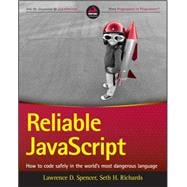Reliable JavaScript, How to Code Safely in the World's Most Dangerous Language demonstrates how to create test-driven development for large-scale JavaScript applications that will stand the test of time and stay accurate through long-term use and maintenance. Taking a test-first approach to software architecture, this book walks you through several patterns and practices and explains what they are supposed to do by having you write unit tests. Write the code to pass the unit tests, so you not only develop your technique for structuring large-scale applications, but you also learn how to test your work. You'll come away with hands-on practice that results in code that is correct from the start, and has the test coverage to ensure that it stays correct during subsequent maintenance. All code is provided both in the text and on the web, so you can immediately get started designing more complete, robust applications.
JavaScript has graduated from field-validation scripts to full-scale applications, but many developers still approach their work as if they were writing simple scripts. If you're one of those developers, this book is the solution you need to whip your code into shape and create JavaScript applications that work.
- Write more concise and elegant code by thinking in JavaScript
- Test the implementation and use of common design patterns
- Master the use of advanced JavaScript features
- Ensure your code's conformance to your organization's standards
If you're ready to step up your code and develop more complete software solutions, Reliable JavaScript is your essential resource.








